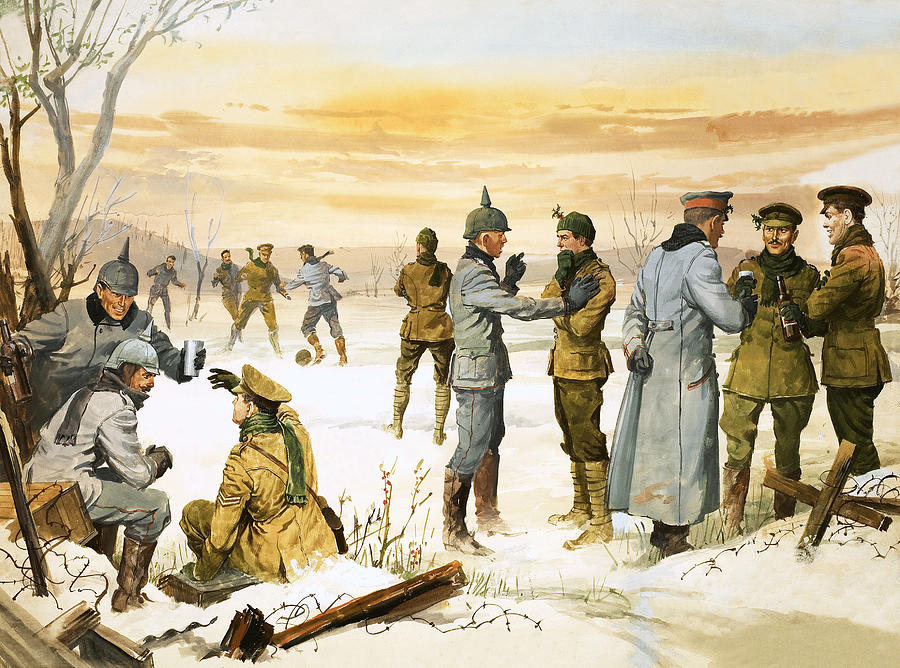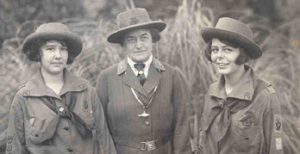The chilling cold was inescapable and constant along the trenches. This was only worsened by the rain-water flooding the muddy walls and floors. Some months had passed since the beginning of World War I, and it was now December of the year 1914. Being “home by Christmas” was out of the question, and a seemingly insuperable stalemate had been reached along the trenches stretching from the Alps to the English channel. The area between these trenches is what was known as “No Man’s Land.” This name was not a novelty in history, but it certainly increased in accuracy since its first usage. Soldiers, young men sometimes as young as fifteen, were dying by the thousands, killed by the indiscriminate fire of the machine gun, a recent addition to the arsenal of armies.1
The Allied Forces had just held off the invading German army along the Marne river, in what was called the “Miracle of the Marne.” The allied victory here signified the failure of the “Schlieffen Plan,” Germany’s attempt at sweeping a 180-degree rotation through neighboring Belgium and France. This strategy would require German troops to rapidly defeat French forces, so that they could be speedily transported via train to what would be the Eastern Front, where Russia would hopefully be slow to mobilize.2

The first trenches were dug on the western front immediately after the Battle of the Marne, which ended on September 12, 1914. The trenches were dug to survive the incoming attacks more easily. However, these trenches would later mark the border into a place of almost certain death.3 The battles of Verdun, the Somme, the Hundred Day Offensive, and Spring Offensive, fought on the Western Front, ended the lives of 5.5 million men. Sixty thousand British soldiers died on the first day of the Battle of the Somme, a death-count still unparalleled in British military history.4
The time in between battles in the trenches was miserable. The 700-kilometer system of parallel trenches was infested with rats, lice, and the bodies of dead horses and men, whom they would stop burying, because the count was so high and because they simply could not reach the bodies without a high risk of losing their own lives in the process. Crosses scattered around the trenches marked the resting places of fallen men, and also provided a grim reminder of the brutality they faced. These insane living conditions led to death by diseases such as dysentery, typhus, or cholera. This place could easily be likened to Hell on Earth. The area between trenches supported this description, a wasteland of barbed wire and tree trunks with no branches.5 Day and night, this is what the men at the front would experience. In fact, the German Expressionist Otto Dix described the trenches eloquently:
“Lice, rats, barbed wire, fleas, shells, bombs, underground caves, corpses, blood, liquor, mice, cats, artillery, filth, bullets, mortars, fire, steel: That is what war is. It is the work of the devil.”6
But then came December. A different feeling was noticeable and written about by the men in the trenches. Sniping had grown rarer, and both French and British soldiers could occasionally hear sentimental singing from the German trenches. Naturally the higher ups thought this to be some sort of tactic by the Germans. Lit up trees would appear, and shortly after, singing would ensue. The French and British soldiers were baffled, because Germans were supposed to be “barbarians.” The Christmas trees that would appear in the not so distant German trenches were somewhat of a novelty to French and British soldiers. However, they were part and parcel of the German Christmas that year.7 Some of the British soldiers shot at the Christmas trees at first, not knowing what to expect. Imagine that after shooting several times at targets near the Germans, they start calling out, promising not to shoot. After months at war, this would not make any sense to war-hardened soldiers.8
A literal calm came on the 4th of December, when an absence of gunfire was reported in some locations. The next day, a royal engineer by the name of Andrew Todd wrote to the Edinburgh Scotsman that soldiers were being “pally” with the enemy. He described their interactions, which included playful cursing at each other, and tossing newspapers from one side to the other, in places separated by only sixty yards. In a card to his mother, one rifleman wrote about how the Germans had peacefully come up and collected some of their wounded, and the British quickly went and collected their own, and after talking, both sides decided to help in burying each other’s dead. The rifleman went on to describe the enemy soldiers as “fine men.” These interactions only increased the closer they got to Christmas. By December 20, both Allied forces and Germans were intent on celebrating Christmas. In preparation of a gift exchange, British forces prepared to give brass boxes, which had been given to them by the crown. These boxes contained cigarettes and pipe tobacco, as well as a greeting card that read “May God protect and bring you home safe.” The Germans, on the other hand, provided some musical entertainment, cigars, and beer imported from as far away as Munich. In a semi-official report, Major Jeffreys provided a description of “A Christmas Onslaught onto the Field-Grey (troops)” as follows:
“Yesterday about Four-o’clock in the afternoon there was a fierce and terrible onslaught of Christmas packages onto our trenches. No man was spared. However, not a single package fell into the hands of the French. In the confusion, one soldier suffered the impaling of a salami two inches in diameter straight into his stomach…. Another had two large raisins from an exploding pastry fly directly into his eyes…. A third man had the great misfortune of having a full bottle of cognac fly into his mouth.”9
Enemies were “fraternizing” with each other. Men who had been killing each other the previous four months, living in disease-riddled trenches, were singing together, playing soccer, getting drunk, throwing down their guns and smoking a cigar or two.10 The Brits sang ‘cheeky’ songs, eventually followed by Christmas carols, and “God save the King,” and the Germans sometimes sang too, accompanied by musical instruments.11 Christmas trees adorned the trenches, and a true spirit of Christmas had possessed these men, a true miracle really.
But the year was 1914, and the war would last until 1918. The continuation of the war would eventually return, because of people like Captain Rudolf Binding, a Hussar who in a letter complained to his father that if he were in power, Christmas would be banned for the year. Measures taken to resume the war, included the banning of future fraternizations with the enemy and an increased pressure on generals to end the peace, in some cases by making the men believe that the truce was part of a nefarious plan by the enemy. This eventually led to more killing, however, in a less eager manner.12 Upon the setting of the sun on Christmas day, one soldier in St. Yvon, twenty-six-year-old Lieutenant Charles Bruce Bairnsfather described a feeling that “It was just the sort of day for peace to be declared.” He talked about wishing that a telegraph boy would reach him with a letter from the King telling the troops that the war is off, and to go back home.13 That day did not come soon.
It is important to note that this truce was informal, and did not only include a single truce but several throughout the trenches. It is said that one similar, yet much less enthusiastic truce was struck in 1915. However, by that time, the propaganda on the barbarity of the Germans had been spread more aggressively.14 There was peace, but not only peace. In one of the most inhumane wars in history, individual men crossed the place called “No man’s land” and shook their enemy’s hand. They complained about the damn war, and wished each other a Merry Christmas.

- Stanley Weintraub, Silent Night (Free Press, 2001), 9; John Keenan, An Illustrated History of the First World War (Alfred A Knopf, 2001), 170. ↵
- Terrence M. Holmes, Absolute Numbers: The Schlieffen Plan as a Critique of German Strategy in 1914 (Sage Publications, Ltd. 2014), 197-199. ↵
- John Keenan, An Illustrated History of the First World War (Alfred A Knopf, 2001), 180. ↵
- The Oxford Companion to British History, 3 Apr. 2018, s.v. “Somme, Battle of the,” by David French. ↵
- Jay Winter, The Legacy of the Great War-Ninety Years On (University of Missouri Press), 26-27. ↵
- Stanley Weintraub, Silent Night (The Free Press 2001), 2. ↵
- Modris Eksteins, Rites of Spring (New York: Houghton Mifflin Harcourt, 2000), 110-111. ↵
- Kathryn N. McDaniel, Commemorating the Christmas Truce: A Critical Thinking Approach for Popular History (Society for History Education), 92. ↵
- Stanley Weintraub, Silent Night (Free Press, 2001), 11. ↵
- Stanley Weintraub, Silent Night (Free Press, 2001), 9. ↵
- Kathryn N. McDaniel, Commemorating the Christmas Truce: A Critical Thinking Approach for Popular History (Society for History Education), 92. ↵
- Michael S. Neiberg, Fighting the Great War- A Global History (Harvard University Press, 2006), 70. ↵
- Stanley Weintraub, Silent Night (The Free Press, 2001), 16. ↵
- Kathryn N. McDaniel, Commemorating the Christmas Truce: A Critical Thinking Approach for Popular History (Society for History Education), 92-91. ↵



126 comments
Belia Camarena
This story never ceases to amaze me. It is incredible that these men went from killing each other and constantly shooting at each other to singing and playing games together on Christmas day. Although this is hard to believe, it is truly a Christmas miracle because the humanity of these men triumphed the darkness of war that the were all submerged in.
Saira Castellanos
I knew alot about what was written in this article because its basic high school history. I hate that we are all obviously capable of peace, and yet we still have wars. If we could do it for Christmas then we can do it always. Peace should not be seen as a miracle, but sadly it is. People are more surprised when there is peace than when there is violence because we got so used to it. No mans land has always intrested me and i like seeing stories on it, like when Wonder Woman went straight through with out a problem. Great article!
Suvesh Vasal
I had a little bit of knowledge about the truce that occurred on Christmas day. But I was unaware that it lasted a few weeks! This article was really interesting to read and I enjoyed reading it. It was filled to the brim with details and the quotes were great. The only thing I would change about any part of the article was that it was longer. I wanted to read more about this miracle on Christmas.
Maria Esquivel
This was an interesting article from start to finish. I remember hearing a little about “No Man’s Land” in class, but reading about this story really puts things into perspective. It’s horrible to read that boys, as young as 15, had to endure and see these horrendous acts. However, it was nice to read that during December there was some sort of peace by both sides, and that they each wished each other a Merry Christmas. Overall, I really enjoyed learning about this event, Great Job, Edgar!
Hannah Wilson
I have always loved this story. It is fascinating to me. It also makes me sad because it shows the peace that could have been if people saw their enemy simply as other people like they did during this moment. The article was very well-written and informative. I think it told the story really well and kept me captivated the whole time even though I have read the story multiple times.
Destiny Leonard
This was such a great article. In a way it made me feel as though maybe there are a such thing as Christmas Miracles. It was interesting to see how despite these groups of men being on opposing sides of a war they were able to overlook this and stop fighting to celebrate Christmas with peace.
Lewis Wilson
This story is incredible. It is so hard to comprehend that the soldiers were willing to lay down their guns and make peace with each other for such a short time. It just goes to show how they did not want to be there fighting each other, and that wars are a very strange time in which people are made to kill each other, sometimes for very wrong reasons. This article was really good, and very informative as I had heard about this truce before but never knew the details.
Thomas Fraire
this was an incredible article! Enthralling and Informative in the meantime. The perusing shared clear cases of what it resembled to be stuck in the trenches among the invasions that occurred inside, making a frightful domain for the young fellows in there. It was an overwhelming time that took a huge number of youthful lives, the greater part of whom were taught, understudies. In any case, the splendid side of the story was the courageous occasion of Christmas, which for two or three days, all viciousness ground to a halt. This demonstrates they are on the whole simply individuals who share a typical good estimation of tranquility on earth and regarding each other. In the event that lone the supernatural occurrence of Christmas could have finished the war then as opposed to proceeding. General extraordinary article!
Natalia Flores
This breaks my heart. Not only were both sides not willing to fight, but both sides had no qualms with the other. The fact that they had to fight later on for the next 4 years is unimaginable. It really makes you wonder that if peace is this easy, why hasn’t it been done? What truly blocks us from spreading peace? It seems that only a select few really desire war while the rest of us simply want to live out our lives. The last image of the famed soccer match is a beautiful close.
Reese Lujan
The author did a great job at giving us examples that allowed us to get a mental image of what it was like to be in the trenches. It really portrayed the horrible surroundings that the young men were put into. It was desperate times that took away many lives the many young educated college men. It’s amazing how during Christmas the violence stopped just so that there would be a peaceful day that showed the true miracle of Christmas.